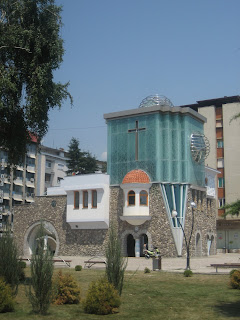

Crete, the largest island in Greece, consists of four prefectures: Chania, Rethymno, Heraklion and Lassithi. I spent only 3 days here and could have probably spent more than a week.
The first part of my journey was in the western town of Chania. Chania is known for its Venetian architecture and harbor. During my visit in Chania, there was a Cretan agricultural festival. Vendors showcased many of the island’s products, including honey, raki (alcohol), puff pastries and desserts. The festival also consisted of children performing Cretan dance in traditional costumes.
The only beach I ventured to in Crete was in the westernmost part, a place called Falassarna. This beach had sparkling blue-green waters and was surrounded by mountains. I felt like I was in heaven!
I next headed to the largest city in Crete, Heraklion. Heraklion is a big city with only a few Venetian structures, notably its fortress and walls. Most people visit Heraklion because it is near the Minoan capital of Knossos. I had the opportunity to wander amongst the ruins of Palace of Knossos. Striking features of the place include colorful columns, reconstructed frescoes and an ancient toilet with sewage system.
The absolute highlight of my stay in Crete and probably in all of Greece was staying with CouchSurfer Antonis’ family. From the moment I set foot in his house, I felt like a part of the family. Antonis’ mother made all sorts of delicious food and made sure no one left the table without being 100% full. Her creations included homemade yogurt, homemade ice cream, cheese pastry, chocolate muffins and Greek salad (with plenty of feta, of course). Antonis, his brother George and parents were very friendly and made sure I felt comfortable at all times. Antonis exposed me to raki (alcohol of the region), meze (Greek tapas) and loukamedes (deep-fried dough balls with honey).
While visiting Antonis’ family, I got a treat of a lifetime--the opportunity to attend a Greek family party! The reason I was so excited is that having watched the movie My Big Fat Greek Wedding, I wanted to experience Greek family life and see first-hand if the gatherings were really that raucous and gossipy. The truth is, the party I attended (which was to bid Antonis’ cousin farewell before he goes on military service) was much milder than the one in the movie. First, everyone was so friendly! They wanted to know how I met Antonis, and that was it. I didn’t feel they were that gossipy. Instead, they kept on offering me food and making sure I tried everything! The food list (which I am sure I forgot to list some items) is as follows: pork ribs, grilled chicken with potatoes, beef stew with pasta, goat cooked with yogurt and carrots (Antonis’ uncle’s “secret” recipe), Greek salad with olives and feta, asparagus casserole, eggplant casserole, dolmas (rice wrapped in leaves), raki, homemade white wine, ice cream, cheesecake, mini cakes, pudding, grapes and watermelon! This Greek family party will certainly go on my list of most memorable life experiences.
To digest all this food, I briefly joined in a Greek “circle” dance in the village square. The town was having a traditional dance performance (with Cretan costumes, of course) and opened up the stage to the public afterwards.
I had a difficult time saying goodbye to Antonis and his family. I was very touched at how friendly there were to a stranger. They exposed me to Greek and Cretan culture by opening both their home and their hearts to me. They showed me why Cretan hospitality is one of the best in the world.
On a side note, I felt proud and honored when Antonis’ dad said “So CouchSurfing works” before I left. This is just one of many examples at how CouchSurfing is breaking down cultural barriers, enhancing understanding between different peoples and building friendships all over the world.








































